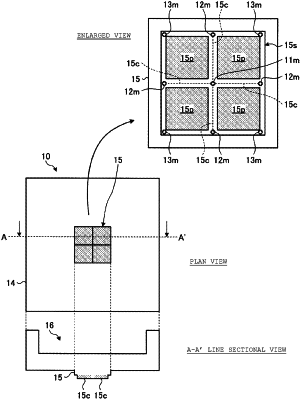| CPC G03F 7/0002 (2013.01) [H01L 21/0271 (2013.01)] | 6 Claims |

|
1. An imprinting apparatus comprising:
a template stage configured to hold a template;
a substrate stage configured to hold a substrate;
a stage base to which the template stage is fixed;
a liquid dispenser;
a first image sensor positioned to detect a first alignment mark included in the template and generate a first detection signal of the first alignment mark;
a second image sensor positioned to detect a second alignment mark included in the template and generate a second detection signal of the second alignment mark; and
a controller configured to:
control the liquid dispenser to apply non-solidified resin onto a surface of the substrate held by the substrate stage;
control the stage base to move toward the substrate stage, such that the template held by the template stage is placed onto the non-solidified resin applied onto the surface of a substrate, such that the non-solidified resin extends into a pattern of the template in a surface direction of the substrate, the substrate including a third alignment mark and a fourth alignment mark;
detect a first timing when the non-solidified resin has extended into the first alignment mark and not yet into the second alignment mark, based on a peak of the first detection signal having reached a brightness threshold and a bottom of the first detection signal having reached a darkness threshold, and a peak of the second detection signal having not reached the brightness threshold or a bottom of the second detection signal having not reached the darkness threshold;
upon detection of the first timing, start a first alignment operation to align the template with the substrate such that the first and third alignment marks fall within a first predetermined deviation;
detect a second timing when the non-solidified resin has extended into the first and second alignment marks, based on the peak of the first detection signal having reached the brightness threshold and the bottom of the first detection signal having reached the darkness threshold, and the peak of the second detection signal having reached the brightness threshold and the bottom of the second detection signal having reached the darkness threshold, the second timing being after the first timing; and
upon detection of the second timing, terminate the first alignment operation and start a second alignment operation to align the template with the substrate such that the second and fourth alignment marks fall within a second predetermined deviation.
|